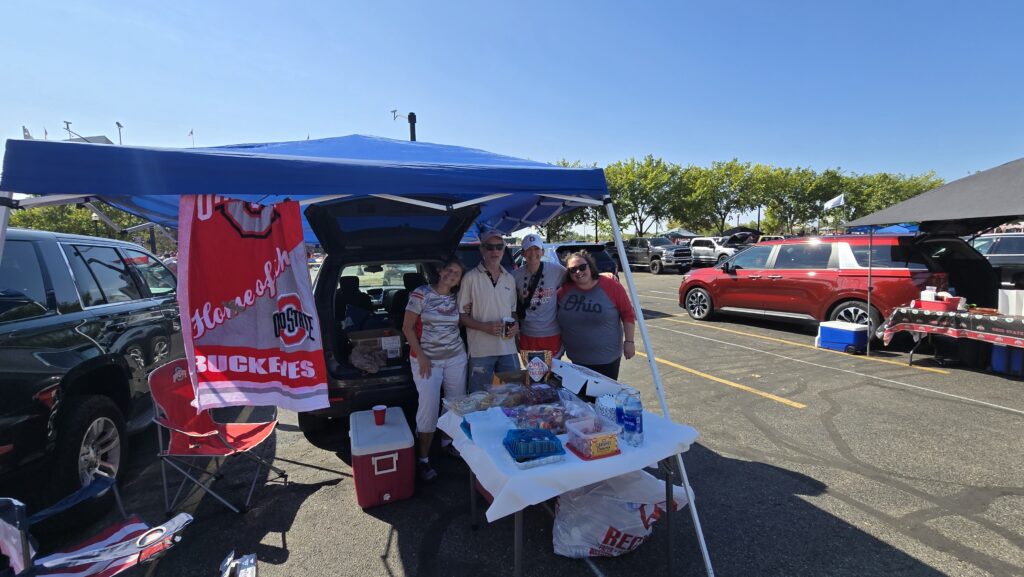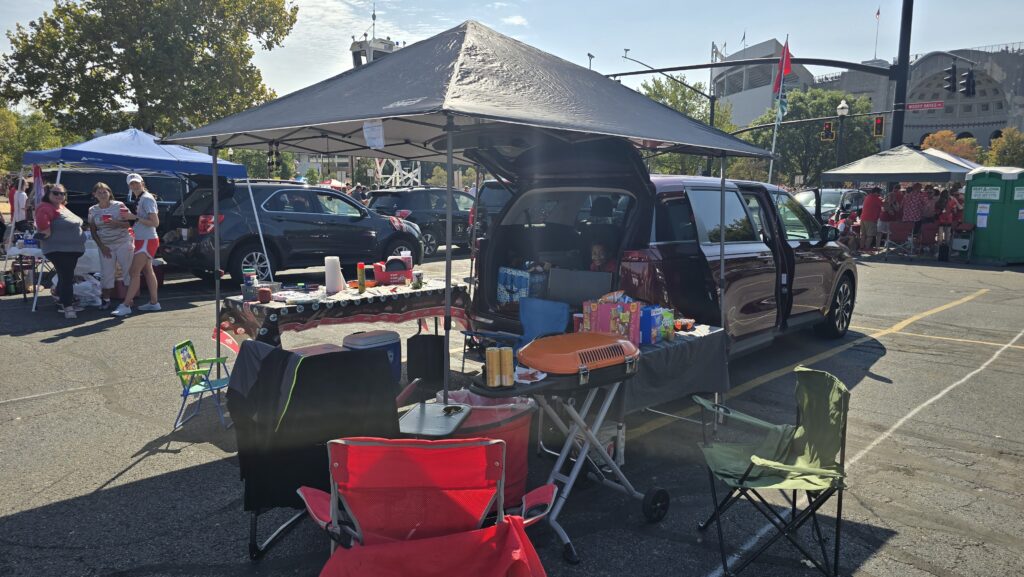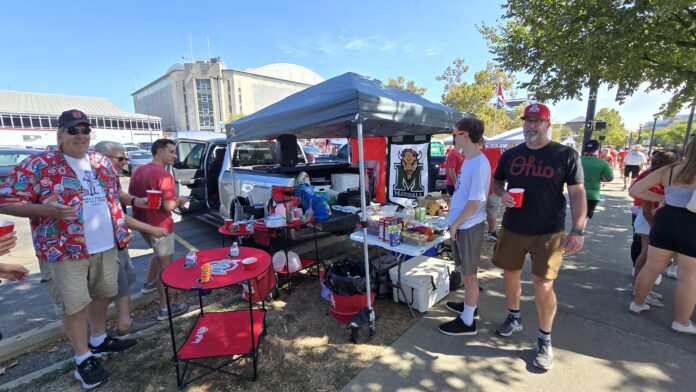Some History
It’s July 21st, 1861, and the Virginia countryside is full of friends and families gathered in close circles. Their buggies are pulled in around them, full of food, drinks, and picnic blankets. But unlike a traditional picnic, enjoying the sounds and views of nature, these close groups are perched on a hill to watch over The Battle of Bull Run, the first major battle of the Civil War. Only 8 years later in 1869, Rutgers and Princeton play the first football game, and people from all around New York pulled their coaches and buggies to the sidelines to enjoy the game in leisure. A number of decades later, the automotive industry arrived and with it the ability to bring groups of people and their belongings long distances easily. And now in 2024, the tradition continues. Hours before kickoff, folks gather from all over the place to eat, drink, and socialize in proximity to the game they have shared interest in. The history of the tailgates we know now likely started on that Virginia countryside hill in 1861, and although much has changed in the world since then, tailgates are still the same pastime they used to be. Good activities, good people, and at the center of the commotion, a vehicle. My name is Jude Gill, and for my senior capstone design project I am working with Honda to identify the areas where the frunk, or front trunk, of electric vehicles can be improved to better optimize the user experience through the lens of my research. My research focuses on the electric vehicle and frunk as it is used for event hosting and tailgating, and how the vehicle has become a centralized part of bringing together communities at these parties.
Primary Research
After learning the historical significance of tailgates and their connection to vehicles, I chose to do primary research at popular tailgating locations. Ohio State game days are enormous, so I had a variety of places to choose from. I spent most of my time in the parking lot of the French Field House, where several hundred groups gather each Saturday for game day festivities. I brought with me a survey that asked key questions about electric vehicle usage in relation to the tailgate, as well as other aspects of drivers daily uses. While the survey was able to provide me some useful data, being present there provided experiences the survey by itself could not. Here’s some of what I noticed.
As I walked around these concrete lots full of football fans and their friends and family, the sense of community present at the site was impossible to go unnoticed. Eating, drinking, singing, dancing, and an incredible amount of joy from those at the parties. And it wasn’t something that was just for themselves, these strangers that I had never met were making sure that I, someone they had zero connection to, was having a good time with them. As I walked around to find people to take my survey, I was given smiles and offered directions to anywhere I was going, and even offered fresh food off the grill or snacks from the bar of a few survey participants. As someone who didn’t grow up around athletics and never had much interest in them, this scene was completely foreign to me; and it felt great! It did not take me long to understand how these kinds of events bring people together.
Sense of community is crucial to these scenes, but it isn’t tied to nothing- while community is mainly a social phenomenon there are objects and settings that aid in making a space have that sense of togetherness. Tables, coolers, grills, and popular food and drink items are all examples of things that bring people together at the site of the tailgate. But among the most important commodities for these parties is a vehicle. The vehicle is the center of the party; it’s where everyone and everything comes from to set up the scene, and where it all goes back to at the end.
Secondary Research
To structure the research for this project, I organized my research findings in a number of sections. With each section, the goal is to gather relevant information, review it, and compress that information into useful knowledge on vehicles and users in the form of a conjecture. Starting with Science and Tech, what are the newest findings in science and tech, and what can we learn from them about the direction of electric vehicle design? An article High-Tech Cars Might Be More Trouble Than They’re Worth from Lauren Leffer details some of the quarrels that follow new age vehicles. Specifically, with the concept of more involved and more technologically advanced vehicles, the increased complexity comes with the increased cost of repair. More things to fix, and often more difficult to fix for local providers that may not have the tools needed for specialty products. My conjecture, the “Frunk-Fix-Kit” aims to address this issue by allowing the vehicle owner the affordance of fixing it themselves. The tools needed for their model of vehicle are stowed in the frunk, allowing the user to fix the problems their providers wouldn’t offer to do themselves. This design features a central handle that can be pulled up to reveal sectioned and sorted drawers for specialized tools, as well as a larger storage area underneath for heavier tools or additional replacement car parts.
Continuing with the Business section, I chose to bring attention to the article The future EV? Electric sports car concept inspired by nature revealed From Electric & Hybrid Vehicle International which brings attention to the places mainstream car designers are finding inspiration for their newest lines of electric vehicles. They bring focus to connecting users to nature with their vehicles, and how designers and car brands want their users to associate their cars with natural things. My conjecture aims to take a very direct approach to a scene that involves vehicles and nature: Farmers Markets. Market stand owners and the farmers that supply them are closely tied to their vehicles, they are essential parts of their jobs. The goal of this design, the “Farmers Frunk”, is to capture the environmentally conscious choices of the EV industry while also being something that a market stand would be proud to show off.
The arts section of my research provided some challenge in finding inspiration, but I was able to find a lot from the articles How Strategic Home Organization Elevates Your Interior Design by An Inspiring Home Interior Design and An Artist’s Truck That’s No More Than It Needs Be by Richard Chang about how a vehicles changing design could be interpreted from an artistic point of view. My conjecture, “Step-up Storage” aims to address the massive variety of needs that users want from their vehicles. Many users want different things with their space, which is to be expected. We all have different wants and needs, and a single design would not be able to capture everyone’s desires. My design does not offer a single obvious use, rather it is a way to offer new affordances for the extra space that a frunk provides.
The final section of my newspaper is my focus, and where my main goal resides. Vehicle ownership is a crucial part of the tailgating experience, so how can a vehicle’s design be aimed at bringing together a community to enhance these events? I’d like to bring up an article written by Taylor Wiley, “‘Like an Irish Pub’: Community and Bonding at Tailgates”. Taylor details the historical significance of tailgates, and how they can bring people together from all walks of life, “Community is the life blood of the tailgating experience. Without community, the act of tailgating would not be as purposeful for its participants. While tailgates are framed as being centered on the football experience, the true importance of tailgating does not chiefly lie in the spectacle of the game; rather, it is the act of connecting with fellow fans and strengthening bonds among friends, family, and acquaintances that is a major factor of tailgating”(Wiley, 2016). Knowing this, as well as what I was able to learn from witnessing these tailgates in person and surveying the folks who attend them, I made my focus conjecture. The idea is to bring convenience to the frontline, and combine the major objects and focuses of tailgating directly into the vehicle itself. With a mounting bracket under the hood of the car, built in speakers and outlets, this frunk is meant to supply tailgaters and event runners with an easy and effective setup that guarantees the attention of those interested in joining them for game day.





Breaking Down the Survey
Below is an infographic depicting the most important answers from my survey. I had 36 respondents, all of whom were electric vehicle owners. I asked them about what they used their vehicles and frunks for, how often they used them, their current thoughts on features and quality, and identifiable issues with their frunk.

I’d like to point out on the top left, that there is a noticeable change in the number and severity of present issues as the graph moves more right. In other words, users that attended more tailgates or used their vehicle for tailgating more frequently, were more prone to finding problems with their frunk. Another detail from the survey that will be relevant going into the design phase, is the demographic chart on the top right. It was unexpected that the graph is almost completely linear, that as age increases the frequency in attendance does as well.
Where to go from Here
As identified previously, my goal with this research and design project is to find a connection between the vehicle and the tools users need for fostering community. It’s apparent from my primary and secondary research that vehicles already serve a role in this, but the problem is that it isn’t their focus. Given that EV’s are a growing field and we know that they are capable of aiding in building community, what conscious effort can we make in the designs of these vehicles to make that a selling point and not a side effect? And in the context of being electric, how can we as designers utilize the generic frunk space to achieve this effort?
Reference:
Posted by Dylan Rider on September 11, 2024 in Editor’s Column. “Editor’s Column: The Art of the Tailgate.” The Ferris State Torch, 11 Sept. 2024, fsutorch.com/2024/09/11/editors-column-the-art-of-the-tailgate/.
Wiley, Taylor. ““Like an Irish Pub”: Community and Bonding at Tailgates.” IU South Bend Undergraduate Research Journal, vol. 16, 2016, pp. 12–18, scholarworks.iu.edu/journals/index.php/iusburj/article/view/22179.
Klein, Christopher. “Tailgating: How the Pre-Game Tradition Can Be Traced to Ancient Times.” HISTORY, www.history.com/news/tailgating-history-football-game-traditions-rituals.
Leffer, Lauren. “High-Tech Cars Might Be More Trouble than They’re Worth.” Scientific American, 2023, www.scientificamerican.com/article/high-tech-cars-might-be-more-trouble-than-theyre-worth/.
Billington, James. “The Future EV? Electric Sports Car Concept Inspired by Nature Revealed.” Electric & Hybrid Vehicle Technology International, Electric & Hybrid Vehicle Technology International, 24 Sept. 2021, www.electrichybridvehicletechnology.com/news/concept-vehicle/the-future-ev-electric-sports-car-concept-inspired-by-nature-revealed.html.
Morrell, Jennifer. “How Strategic Home Organization Elevates Your Interior Design.” Aninspiringhome.com, 8 Jan. 2024, www.aninspiringhome.com/how-strategic-home-organization-elevates-your-interior-design.




